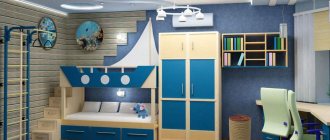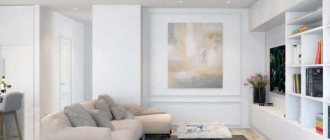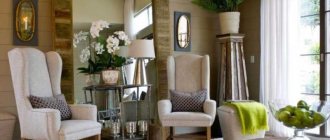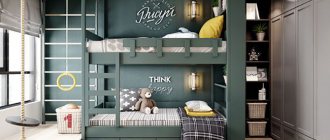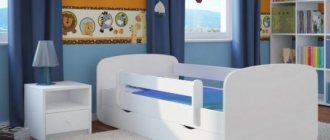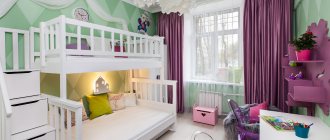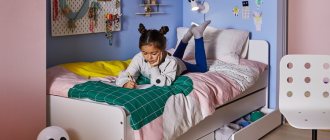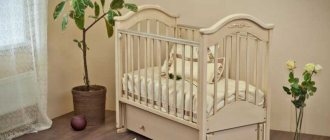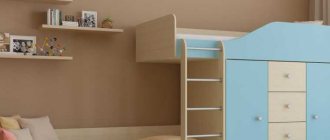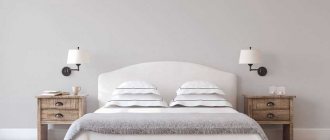In order for your child to have good academic performance, it is important to properly design his learning area. This will be discussed in the article.
When your child becomes a school student, it completely changes his way of life, which means that his room must undergo significant changes. After all, now the child will not only sleep and play in it, but also learn and create, the number of his things will increase significantly. Taking this into account, parents should take care in advance to ensure that the design of the children's room best suits the growing needs of the growing student.
Schoolchild's room: design, general recommendations
- If there are two children in a family, then you need to think through the design of a schoolchild’s room for two so that they do not interfere with each other’s studies. But you can save on sleeping space by installing a bunk bed.
Together
- You need to understand that a girl’s schoolroom and a boy’s room should be different from each other. In addition, it is better to divide the entire space of the room into zones, fill it with soft colors, functional furniture, provide proper lighting, and be sure not to forget about the play corner. We will consider all these nuances below.
- As noted above, a student’s room should carry a multifunctional load - from the bedroom to the study. Therefore, it is extremely important to create zones that differ in functionality and, accordingly, in design and content. This will help discipline the baby and not distract his attention, switching, for example, from books to toys. And it’s much easier to clean in a zoned space.
Zoning
- To divide an entire room into functional zones, it is not necessary to arrange multi-level ceilings or floors - it is enough to correctly arrange furniture and other interior items. For example, install a wardrobe with sliding doors facing the sleeping area, and equip it with shelves on the opposite side, thus forming a functional “wall” for a work or play area.
- Another option is a portable screen or partition, which, on the one hand, will create a cozy privacy at your desk, and on the other hand, you can hang children’s drawings, photographs, and the like on it.
Student's room
- It happens that for some reason it is impossible to zone a room (for example, due to its limited size). Then you can simply place the desk in one corner (so that the baby sits behind it with his back to the toys), and move the bed and play area to the far corners.
How is the school room different for boys and girls?
First, let's clarify what a modern room for a schoolboy boy is and how it differs from a room for a schoolgirl girl? Let's start with the fact that you won't find pink, delicate tones in a boy's room. Guys of all ages prefer blue, green, gray and light blue colors, which are associated with the sea, sky, and space. In a schoolgirl’s room, Provence style motifs are often heard, the furniture upholstery is in pastel colors, and the headboard of the bed is decorated with a fabulous canopy.
Features of room design for two schoolchildren at once
It is not easy to create a comfortable space in a few square meters that would be comfortable for two children, and of opposite sexes. Taking into account age, gender and temperament, a room for two schoolchildren can be equipped with a bunk bed, if the children's area allows - two identical tables (or one L-shaped). Children must be assigned a personal bedside table or closet. You can globally divide a nursery between two children by zoning the room with color, light and furniture arrangement. As, for example, in the photo:
Children's room for two schoolchildren of different genders
A room for schoolchildren, a girl and a boy, should have a single design concept, but the separate zones are different based on gender. You can visually divide the children's room, but unite the children themselves, using furniture that is the same in style, but different in color and content.
Color design of a schoolchild's room
- If you do not plan to carry out major renovation work in the nursery every year, such as repainting the walls or re-gluing the wallpaper, then it is better to opt for a neutral color scheme. This will allow you to make adjustments over time to the interior of a child’s room for a schoolchild (furniture, decoration, decorative elements) without spending too much money and effort.
In calm colors
- Another advantage of calm colors in the interior is their positive impact on the psyche of a growing schoolchild. After all, the right colors will help you concentrate in the work area and relax in your bed for a good rest.
Boy's room
- Psychologists advise arranging some bright oases - interior details on which the eye will linger. But there shouldn’t be too many of them, and always against the background of light walls and ceilings (ideally they should be white in combination with beige, soft gray, green and blue).
Vivid details
- For a work corner, colors that stimulate attention and encourage successful activity are suitable: soft, muted yellow, greenish, blue, orange and brown. Moreover, there can be quite a lot of green, and the rest of the colors should simply be “present” in the work corner in the form of the same accents (it is best if this is some important information - such as a lesson schedule or daily routine - done on a colored background).
Furniture for a schoolchild's room
- Not only comfort, but also health – and directly – depends on the ergonomics of furniture for a schoolchild’s room. And since children grow quickly, it is better for them to purchase tables and chairs “with a reserve” so that they can, if necessary, adjust their height and backrest angle.
Choose quality furniture
- The modern furniture market offers a lot of all kinds of furniture for a schoolchild’s children’s room, and in order to make the right choice, you need to either consult with a specialist or choose a table and chair yourself.
- You need to understand that the optimal height of the table surface is considered to be the approximate chest level in a sitting position (a couple of centimeters lower), and the hands should lie on the tabletop without any tension or sagging.
Important Rules
- If the chair turns out to be too high , then you can build a footrest from scrap materials (boxes, books, etc.), involving the small owner of the room in this process.
Measurements
- Most likely, there will not be enough space in the room to place two tables - a desk and a computer, so immediately purchase some kind of hybrid and make sure that it has a sufficient number of drawers and shelves - this will help save space.
Comfort and space are important
Rules for replacing a bed
The sizes of children's beds are regulated by state standards. There are 4 groups in total, in which age is considered the most important characteristic. Furniture dimensions according to GOST:
- For children under 3 years old, the recommended dimensions of beds are: width - 0.6 m, length - at least 1.2 m. The height of the sides should be no higher than 0.95 m, otherwise it will be uncomfortable to lay the child down. Most models have lattice walls. The acceptable distance between the rods is 7.5 cm.
- In furniture for children from 3 to 7 years old, the width remains the same, but the length increases to 1.4 or 1.45 m. The latter value is typical for models from foreign manufacturers. The side barrier is removed and the height of the crib is raised 0.3 m from the floor.
- For schoolchildren under 10 years old, it is important to increase not only the length to 1.6 m, but also the width to 0.8 m. The height remains at the same level. If linen drawers are placed under the bed, it can become 10–20 cm higher.
- For children over 10 years old, the minimum product dimensions are 0.9 x 1.8 m with a height of at least 0.5 m. These parameters are also typical for adult single products.
Nuances of choosing beds for children over 2 years old, types of designs
The moment a child moves from one category to another indicates the need to replace the bed with a larger model. The figures indicated are standard, but average, and therefore do not suit absolutely everyone. Tall children need atypical beds. To independently determine the appropriate length, just add 35–50 cm to your height.
When choosing a children's bed, first of all you need to take into account the age, height, weight of the child. It is not necessary to strictly follow established standards; it is enough to take them as a basis. A responsible approach to organizing a sleeping place will be the key to a complete and comfortable rest for a child or teenager.
For children under 3 years old, the length of the sleeping place must be at least 120 cm
In a bed for children from 3 to 7 years old, the width remains the same, but the length increases to 140 cm
The optimal bed sizes for schoolchildren under 10 years old are 80 x 160 cm
For children over 10 years old, the length of the bed can be increased to 180 cm
Schoolchild's room: lighting
- It is very important to think through the arrangement of furniture and zoning of the children's room so that the work area is sufficiently illuminated - both by natural light and by lighting fixtures.
- The main parameters of illumination should be uniformity, the absence of excessive dimness or brightness - and this applies to both sunlight and the operation of lamps.
- If you plan to hang a central lighting fixture, then you should definitely add additional lighting sources to it - either around the entire perimeter of the room (with stationary built-in lamps) or in certain areas of it (using sconces and table lamps).
Lamps
- In the working corner of the student's room , on the desk (on the left - for those who write with the right hand, and on the right - for left-handers), it is necessary to place an adjustable table lamp so that you can easily change its angle and height. It is best to use a 60-watt white LED bulb with a matte effect.
Need additional lights
- If the student’s desk is near a window, then it is advisable (if possible) to install it perpendicular to the opening.
The main characters in the children's schoolgirl
The main characters in the nursery of a future schoolgirl are no longer toys, but a comfortable workplace (furniture and lighting), as well as places to store textbooks, educational materials and other school supplies.
Particular attention should be paid to the location of the work area. It is necessary for the child to feel comfortable during classes. It is better if the chair on which the child is sitting is located with its back to one of the walls of the room. A child sitting with his back to the door will feel uncomfortable and unprotected.
Lighting is one of the most important aspects in organizing a workplace. We place the table in a well-lit place, next to the window. We are thinking about proper lighting of the work area in the evening. And don’t forget that the light should fall from the left side if the child is right-handed (if the child is left-handed, then the light should fall from the right side).
It is highly desirable that the table lamp have a lampshade. The lampshade makes the light source softer and more uniform. And we remember that the child should not study only with a table lamp; there must be other light sources in the room at this time (wall sconces, light ceiling cornice or general light).
You can read more about how to correctly select furniture in accordance with the child’s height and install lighting in our article “How to organize a schoolchild’s workplace.”
It happens that the size of the children's room does not allow placing a large and comfortable table next to the window. Then some parents transform a wide tabletop-window sill into a desk. But personally, I am not a supporter of such a solution. The light falling on the desk directly from the window is too bright and will blind the child, especially on clear and sunny days. Perhaps translucent versions of roller blinds can come to the rescue, partially blocking the light, but still, this arrangement is not the best.
Choosing a color scheme
When choosing the color of a future room for a first-grader girl, you should focus both on the preferences of the child himself, but also take into account the advice of psychologists. If your child is highly excitable and hyperactive, choose calm tones and cooler shades. For example, turquoise, mint, pale pink, pale green, lilac. Dilute them with white and soft, warm tones. Small bright accents are acceptable, but the overall atmosphere should contribute to a relaxing atmosphere.
For phlegmatic people, on the contrary, we create a more active environment. We choose bright, warm colors that encourage action and lift your spirits. For example, sunny yellow, orange, burgundy, lush green.
It is advisable that the color of the walls in a first-grader girl’s nursery be kept in a calm color scheme. Often it will serve as a backdrop for hanging educational materials, creative works, awards, certificates and just photographs. Colorful wallpaper with bright patterns and flashy patterns are not suitable here.
If the girl really wants bright colors and patterns on the wallpaper, then you can decorate one of the parts of the room in accordance with her wishes - the one that will be designated as a play area. Bright colors can be used in the decor of the study area, as well as in accessories.
The play corner is a schoolchild’s favorite place in the room
- When your baby becomes a schoolchild, he never ceases to be a child, which means that his favorite area in the room will be the play corner.
- That is why the design of a schoolchild’s room from this perspective needs to be thought through very carefully.
In order for games not only to kill the baby’s time, but also to help him develop properly, it is worth planning the appropriate decorative elements:
- planes for creativity (if your child has a penchant for drawing), for learning (all kinds of magnetic or writing boards and the like);
- tables for games, puzzles, crafts or other creative activities;
- musical instruments;
- sports equipment (wall bars, horizontal bars, ropes).
Bright board
Game corner
Compact
Gaming side
It is advisable to put a soft hypoallergenic covering on the floor, because the child will spend a lot of time on it.
Decorative elements in a schoolchild's room as developmental aids
- In any case, you will want to decorate the student’s room with some decorative elements - so why not combine, as they say, business with pleasure?! Let the real “highlight” of the nursery be the decorations chosen with wisdom and love that carry an educational meaning.
- You can stick a huge map of the world (stylized as an antique one, with hidden pirate treasures), put a globe, hang a model of the solar system or the whole starry sky with the main constellations from the ceiling - in fact, there can be a lot of ideas.
World map
Map
- If your child is interested in creativity , then hang reproductions of famous paintings or portraits of writers or composers on the walls. And if he has a penchant for learning languages, then look for wallpaper with the alphabet.
Paintings
- Any parents are undoubtedly proud of their child’s successes - so share his victories with everyone who comes to visit you. To do this, it is enough to create a kind of “honor board” on which you can place the child’s most successful drawings, and, over time, all kinds of certificates and awards, cups and medals.
- The main rule for arranging a “honor board” is the most prominent place in the room, so that it immediately catches the eye of everyone who enters.
- It’s good if you take the time and relatively little money to insert all these awards into frames under glass - this way they will look much more solid and will last longer.
Don't forget about toys
Play activities for children of primary school age continue to be an important element. Be sure to leave space for games and a place to store your favorite toys in your future first-grader’s nursery. Of course, it wouldn’t hurt to do an inspection first, throw away old and broken toys, and give those that the child has outgrown to the younger children of friends or neighbors.
Friends are increasingly visiting your growing daughter. For a comfortable time, you can put several poufs or put large decorative pillows so that they can sit comfortably while playing or watching their favorite cartoons.
Additional Helpers
Think about what your child is interested in, what is he more inclined towards - geography, drawing, design, reading, music or maybe sports? Add accents to the room that suit his interests.
This could be a world map on which you will mark together the places where you have been and where you are going to go. Or a star chart with constellations and planets of the solar system.
If a child loves plants, flowers or animals, organize a mini-flower garden in the children's room or a small living corner so that the child, first with your help and then independently, learns to care for its inhabitants.
A real easel for a future artist will bring a creative atmosphere to the room, and it will be complemented by reproductions of paintings by famous artists and a gallery of the little housewife’s own works.
A hanging hammock chair will help you relieve stress, relax in a homely atmosphere and just be a little alone, sitting comfortably with your favorite book:
Mini library in a schoolchild's room
- Everyone knows that only a child who reads develops harmoniously and comprehensively. So create all the necessary conditions for your child to become an avid book lover!
- Collect his own library with him (bookshelves, racks or cabinets are perfect for this), and also equip a cozy place for reading in the student’s room, which will be fairly well lit.
In the play area
Books
- To create maximum comfort, invite your child to decorate the bookshelves with some miniature objects (toys, souvenirs, etc.).
How should a child's room be decorated for a schoolchild?
First grade is a reason for joy and pleasant updates, including changing the interior of the children's room. How to create the perfect space that will grow with your child?
- First, don't be afraid to show progressive views on design.
- Secondly, remember that the tastes of children (especially teenagers) change quickly. Therefore, when developing a design project, do not forget about the golden rule: choose basic things (bed, wardrobe, table) of simple (straightforward) design and high quality, but you can experiment with furnishing details (textiles, lamps, posters).
- Thirdly, buy school furniture together with the child. But a conflict of interest cannot be ruled out: boys and girls want everything to be more fun, and boring parents think about practicality and convenience. Adults can understand - the table and bed in a student’s room should be safe for health, the closet should be spacious, and chandeliers and sconces should provide a lot of light, but save energy.
Regardless of how “interior” trends change, the approach to decorating a room for a schoolboy or schoolgirl requires simple rules. One of them is dividing the room into zones.
A place to store things, toys, school supplies in a student’s room
- It is necessary to initially think through the interior of the nursery in such a way that all categories of items have their place in it - and in sufficient quantities. Then it will be much easier to clean the room, and there will be no clutter.
- Of course, your baby will gradually accumulate quite a lot of all kinds of things: clothes, toys, school supplies, and so on, which he will not want to throw away or remove from his room.
We store things
- School supplies should be stored in a work area and in such an order that they can be easily reached (desk drawers, shelves, cabinets, bedside tables). Objects that the child constantly uses should be placed closer.
Storage
- Clothes in the student's room should be placed in a wardrobe (recommended depth - 40 cm). The hanger bracket should not be located too high - approximately at the child’s eye level. Pay attention to the drawers: they must not slip out of the grooves so that the baby cannot accidentally injure himself. Another option for storing clothes is a chest of drawers for linen and an open hanger for things that need to be stored on hangers.
- Try to teach your child that toys that he no longer plays with should be gradually disposed of: for example, by giving them to someone younger, and the remaining ones should always be put back in their place after play. Otherwise, you will simply drown in their huge number!
We need to put things in order
- It’s a good idea to store toys in special boxes - having previously organized them according to a principle convenient for the baby.
Children's room for two schoolchildren
So that epoch-making day has come - the children went to school after the holidays. Junior in first grade for a minute! The parents breathed a sigh of relief: hurray, finally there will be an opportunity to complete the play, turn up the faucet in the kitchen and complete the model of the Egyptian pyramid from meatballs.
But it turns out that you won’t be able to relax - the children don’t want to do their homework at the kitchen table, they fight for the only chair and complain about poor lighting! As a caring dad and mom, you simply have no right to stay away. The problem that has arisen must be resolved urgently. But how to choose furniture for a children's room for a schoolboy boy, if there are two boys at once, and there is only one room, and there are not enough meters?
Creative space
Every boy in his room should have a personal space for self-expression, where he can freely realize his ideas, learn lessons and spend time with friends. To do this, think over comfortable workspaces for both boys with identical tables and chairs, racks with many shelves and drawers. Don't skimp on the quality of materials, look for compromises.
Interior of a room for two schoolboy boys
Rest zone
An important element for two schoolchildren are beds. Their design should match the stylistic design of the room, and at the same time be comfortable and match the height of the children. If the size of the room allows, then the beds are placed opposite each other (photo on the left). In a small room for two student brothers, it is possible to order pull-out beds (photo on the right).
Arrangement of beds in a children's room for two schoolchildren
Pull-out bed in a children's room for two boys
Textiles for children's
To make the interior mobile and ready for new changes, you need to pay special attention to fabrics - curtains, upholstered furniture covers, pillows, bedspreads, etc. They set the overall color scheme of the room. What we mean is that when the preferences of the little owners change, it is enough to replace the textile elements and the room will be visually transformed.
Bright accents
A variety of textures are welcome in the nursery. For example, bookshelves can have glass fronts, desk tops can be glossy wood, and lighting fixtures can have metal parts. Decorators advise choosing expressive bright objects with which the room will acquire its originality, together with the children.
Hammock in a schoolchild's room
An extraordinary solution for a nursery of two schoolchildren could be a hammock suspended from the ceiling. Why not - children remain children even during their school years)
